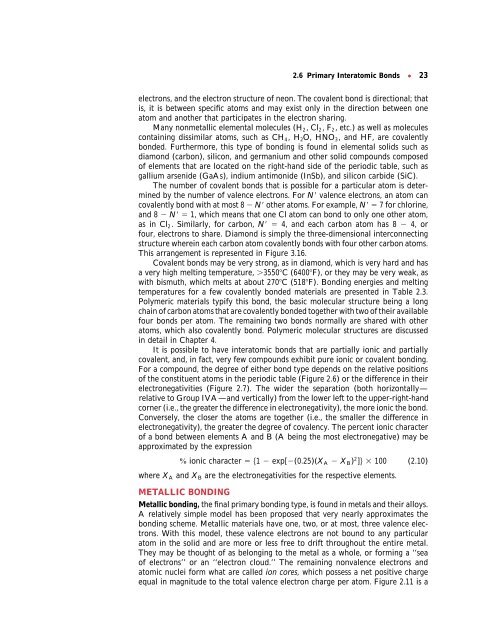Chapter 2 / Atomic Structure and Interatomic Bonding
Chapter 2 / Atomic Structure and Interatomic Bonding
Chapter 2 / Atomic Structure and Interatomic Bonding
Create successful ePaper yourself
Turn your PDF publications into a flip-book with our unique Google optimized e-Paper software.
2.6 Primary <strong>Interatomic</strong> Bonds ● 23<br />
electrons, <strong>and</strong> the electron structure of neon. The covalent bond is directional; that<br />
is, it is between specific atoms <strong>and</strong> may exist only in the direction between one<br />
atom <strong>and</strong> another that participates in the electron sharing.<br />
Many nonmetallic elemental molecules (H2,Cl2,F2, etc.) as well as molecules<br />
containing dissimilar atoms, such as CH4,H2O, HNO3, <strong>and</strong> HF, are covalently<br />
bonded. Furthermore, this type of bonding is found in elemental solids such as<br />
diamond (carbon), silicon, <strong>and</strong> germanium <strong>and</strong> other solid compounds composed<br />
of elements that are located on the right-h<strong>and</strong> side of the periodic table, such as<br />
gallium arsenide (GaAs), indium antimonide (InSb), <strong>and</strong> silicon carbide (SiC).<br />
The number of covalent bonds that is possible for a particular atom is determined<br />
by the number of valence electrons. For N valence electrons, an atom can<br />
covalently bond with at most 8 N other atoms. For example, N7 for chlorine,<br />
<strong>and</strong> 8 N 1, which means that one Cl atom can bond to only one other atom,<br />
as in Cl2. Similarly, for carbon, N 4, <strong>and</strong> each carbon atom has 8 4, or<br />
four, electrons to share. Diamond is simply the three-dimensional interconnecting<br />
structure wherein each carbon atom covalently bonds with four other carbon atoms.<br />
This arrangement is represented in Figure 3.16.<br />
Covalent bonds may be very strong, as in diamond, which is very hard <strong>and</strong> has<br />
a very high melting temperature, 3550C (6400F), or they may be very weak, as<br />
with bismuth, which melts at about 270C (518F). <strong>Bonding</strong> energies <strong>and</strong> melting<br />
temperatures for a few covalently bonded materials are presented in Table 2.3.<br />
Polymeric materials typify this bond, the basic molecular structure being a long<br />
chain of carbon atoms that are covalently bonded together with two of their available<br />
four bonds per atom. The remaining two bonds normally are shared with other<br />
atoms, which also covalently bond. Polymeric molecular structures are discussed<br />
in detail in <strong>Chapter</strong> 4.<br />
It is possible to have interatomic bonds that are partially ionic <strong>and</strong> partially<br />
covalent, <strong>and</strong>, in fact, very few compounds exhibit pure ionic or covalent bonding.<br />
For a compound, the degree of either bond type depends on the relative positions<br />
of the constituent atoms in the periodic table (Figure 2.6) or the difference in their<br />
electronegativities (Figure 2.7). The wider the separation (both horizontally—<br />
relative to Group IVA—<strong>and</strong> vertically) from the lower left to the upper-right-h<strong>and</strong><br />
corner (i.e., the greater the difference in electronegativity), the more ionic the bond.<br />
Conversely, the closer the atoms are together (i.e., the smaller the difference in<br />
electronegativity), the greater the degree of covalency. The percent ionic character<br />
of a bond between elements A <strong>and</strong> B (A being the most electronegative) may be<br />
approximated by the expression<br />
% ionic character 1 exp[(0.25)(XA XB) 2 ] 100 (2.10)<br />
where XA <strong>and</strong> XB are the electronegativities for the respective elements.<br />
METALLIC BONDING<br />
Metallic bonding, the final primary bonding type, is found in metals <strong>and</strong> their alloys.<br />
A relatively simple model has been proposed that very nearly approximates the<br />
bonding scheme. Metallic materials have one, two, or at most, three valence electrons.<br />
With this model, these valence electrons are not bound to any particular<br />
atom in the solid <strong>and</strong> are more or less free to drift throughout the entire metal.<br />
They may be thought of as belonging to the metal as a whole, or forming a ‘‘sea<br />
of electrons’’ or an ‘‘electron cloud.’’ The remaining nonvalence electrons <strong>and</strong><br />
atomic nuclei form what are called ion cores, which possess a net positive charge<br />
equal in magnitude to the total valence electron charge per atom. Figure 2.11 is a



